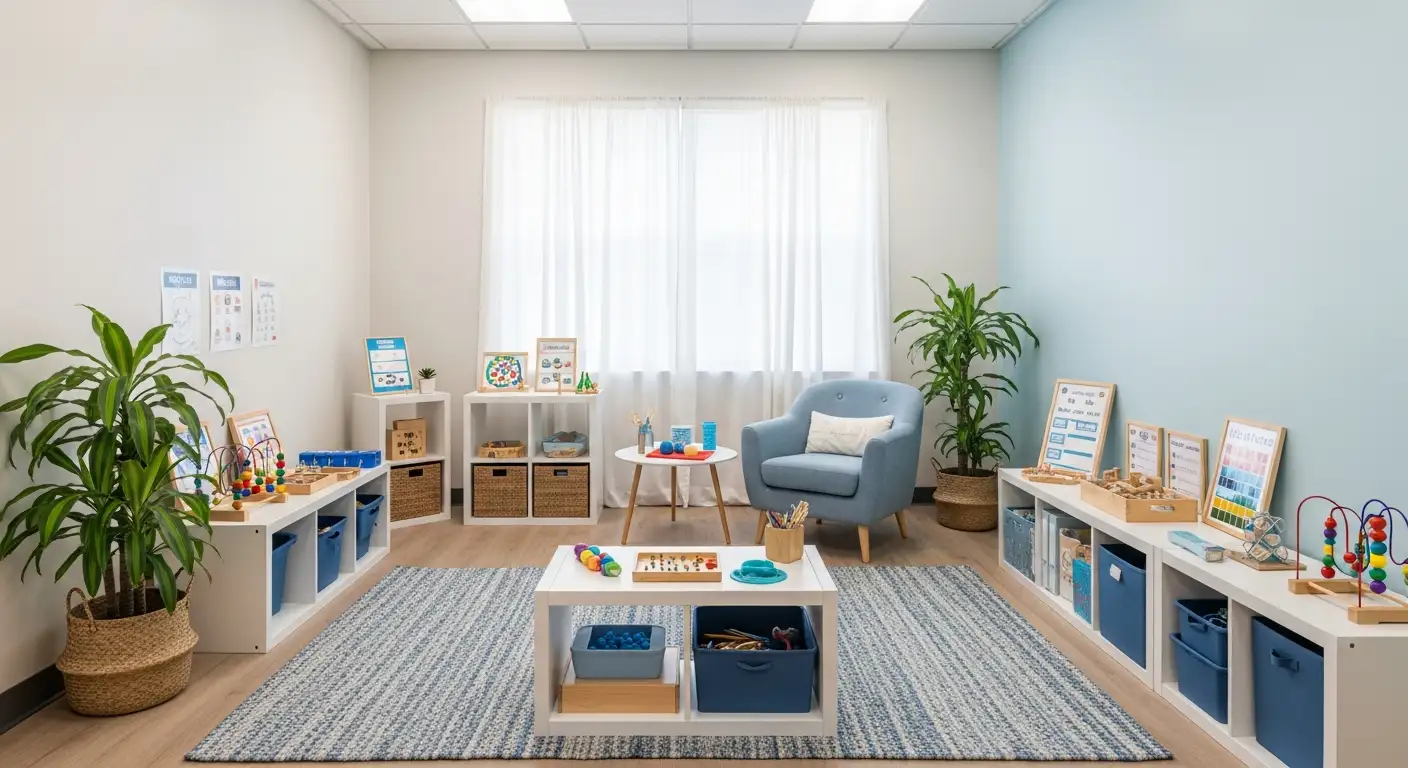Understanding the Foundations of Autism Therapy
Autism therapy is a vital approach aimed at supporting individuals with autism spectrum disorder (ASD) in acquiring essential life skills and reducing challenging behaviors. Central to many successful therapy outcomes is Applied Behavior Analysis (ABA), a scientifically grounded method that breaks down complex behaviors and skills into teachable components. ABA uses structured, evidence-based techniques to help individuals with autism build communication, socialization, and daily living skills, which are crucial for their independence and quality of life. These therapies are often delivered by specialized professionals through individualized programs tailored to each person's unique needs.
The Role of Professionals and Specialized Services in Autism Therapy

What types of professionals provide autism therapy?
Professionals who provide autism therapy encompass a range of trained specialists. These include Board Certified Behavior Analysts (BCBAs), behavior technicians, psychologists, special educators, speech-language pathologists, occupational therapists, and social workers. Many of these experts hold advanced degrees in areas such as psychology, special education, or human development. Additionally, certifications like the BCBA and Certified Autism Specialist (CAS) help demonstrate professional expertise.
These specialists collaborate to develop and implement evidence-based interventions, most notably Applied Behavior Analysis (ABA). Supervision and continuous professional development are integral to ensuring quality care. Ultimately, a multidisciplinary team works together to deliver personalized, effective therapy tailored to individual needs.
Are there specialized companies that offer autism therapy services?
Yes, specialized companies focused on autism therapy primarily provide ABA-based services. These companies tailor evidence-based programs to suit the specific needs of each individual with Autism Spectrum Disorder, often across various developmental stages and ages.
Services are offered in diverse settings including therapy centers, homes, schools, and community environments to promote generalization and naturalistic learning. Encouraging parental involvement is a significant component, as it reinforces skills beyond therapy sessions. Many of these providers accept major insurance plans, improving accessibility to necessary services for families.
Collaboration among multidisciplinary teams
Multidisciplinary collaboration is fundamental to effective autism therapy. Professionals from different specialties coordinate efforts to assess, design, and adjust interventions. This teamwork ensures comprehensive support that addresses behavioral, communicative, social, and educational needs.
Settings where therapy is provided
Therapy takes place in various environments such as clinics, schools, homes, and community settings. These diverse settings help facilitate skill generalization, allowing individuals with autism to apply learned behaviors across contexts.
Parental involvement and support
Parental engagement is vital in autism therapy. Parents often participate in training and consultations to support skill development at home and in everyday situations. This partnership enhances therapy outcomes and fosters consistent progress.
Applied Behavior Analysis: A Cornerstone in Autism Interventions

What is autism therapy and how does it work?
Autism therapy includes various evidence-based methods aimed at supporting individuals with autism spectrum disorder (ASD) to develop vital skills and lessen challenging behaviors. Among these, Applied Behavior Analysis (ABA) is a leading approach grounded in principles of learning and behavior. ABA uses positive reinforcement and behavior analysis techniques to foster social, communication, and everyday living skills.
ABA interventions are highly personalized, devised and supervised by specialists like Board Certified Behavior Analysts (BCBAs). Common methods within ABA include Discrete Trial Training and Pivotal Response Treatment. Additional therapies such as the Early Start Denver Model and social skills groups complement ABA, emphasizing natural interactions and emotional growth. The overarching goal of autism therapies is to enhance function and life quality through well-structured, tailored interventions backed by scientific research.
How does Applied Behavior Analysis (ABA) help individuals with autism?
ABA promotes skill development in individuals with autism by breaking tasks into smaller, manageable steps and reinforcing constructive behaviors using rewards. It involves detailed assessment of environmental factors influencing behavior and uses this data to guide effective behavior change.
Programs are customized to individual needs, with ongoing evaluations to measure improvements across communication, social interaction, and daily living skills. Techniques like positive reinforcement, Discrete Trial Training, and communication aids such as the Picture Exchange Communication System are commonly applied. The ultimate goal is to increase productive behaviors and foster greater independence, contributing to a better quality of life.
How is generalization important in ABA therapy for autism?
Generalization refers to the ability to apply learned skills across various settings, people, and stimuli, which is vital for lasting benefits in ABA therapy. Successful generalization ensures that behaviors acquired during therapy extend to real-world situations.
Assessment involves measuring skill transfer using consistent data collection before and after instruction across different environments and individuals. Promoting generalization employs strategies like training loosely, using multiple examples (exemplars), programming common stimuli, and leveraging natural consequences. For example, using the same behavioral cues or contracts, such as community store rules, helps extend learned behaviors beyond therapy sessions.
When initial generalization is limited, extending training into natural environments with baseline data collection helps improve skill transfer. This continuous assessment and strategic planning ensure that therapy gains are meaningful and sustainable in everyday life.
Generalization in ABA: Why It Matters for Long-Term Success
What is Generalization in ABA?
Generalization in Applied Behavior Analysis (ABA) refers to the ability of individuals, particularly those with autism, to apply learned behaviors and skills across various settings, people, and stimuli beyond the original teaching environment. This means a skill taught in therapy or classroom settings can be effectively used at home, in the community, and with different communication partners.
Why is Generalization Important for Individuals with Autism?
For individuals with autism, generalization is essential because it bridges the gap between therapy sessions and real-life application. Without it, skills might be limited to the therapeutic context and not functionally useful in daily situations. It ensures that behavior changes are not only acquired but also maintained and useful in diverse environments.
What Challenges Exist in Applying Learned Skills Across Settings?
Applying learned skills across different settings can be challenging due to varying stimuli, people, and environmental factors. Therapies conducted in controlled settings may not automatically transfer if cues or reinforcement strategies differ in natural environments. This can cause skills to remain context-bound and limit their practical impact.
How Does Generalization Support Lasting Behavior Change?
Generalization supports lasting behavior change by promoting flexible skill use. Strategies such as incorporating common stimuli (consistent cues across environments), training loosely with varied examples, and using natural consequences help ensure behaviors adapt naturally to different contexts. Measuring generalization through data before and after training in multiple settings confirms the transfer of skills. Extending training into natural environments when needed further strengthens this process.
These efforts ensure that behavior changes are durable and meaningful, improving independence and quality of life for those undergoing ABA therapy for autism.
Assessing and Measuring Generalization in ABA Programs

How is generalization assessed in ABA?
In Applied Behavior Analysis (ABA) therapy, especially for individuals with autism, assessing generalization is vital to ensure that learned skills apply beyond the training environment. Generalization assessment involves evaluating whether acquired behaviors transfer across various people, materials, and environments.
Methods to evaluate skill transfer
Therapists use consistent stimuli — the cues or triggers related to the behavior — and collect data systematically before and after the instruction period. By observing actions in different settings, therapists can track how well the individual applies learned skills.
Use of consistent stimuli and data collection
Stimuli consistency is essential; using the same or similar triggers across settings helps determine if behaviors generalize naturally. Data collected at multiple points allow for monitoring changes and identifying successful transfer.
Pre- and post-instruction assessments
Baseline data gathered prior to training serve as a comparison point. After intervention, assessments in natural environments reveal if the skill persists beyond the original context.
Indicators of successful generalization
Improved performance in untrained or natural settings, sustained over time and across people or locations, signals successful generalization. If initial data show limited transfer, expanding training to new environments with fresh baseline data is recommended to enhance generalization outcomes.
Strategies to Promote Generalization in Autism Therapy

Training Loosely
Training loosely involves varying practice conditions so individuals learn to apply skills across different contexts, reducing reliance on very specific cues from initial training. This encourages flexibility and helps skills transfer beyond the clinical setting.
Use of Sufficient Exemplars
Presenting multiple examples or situations where a skill is used supports the learner in recognizing the core feature of the behavior and applying it appropriately in new environments or with new people.
Programming Common Stimuli
Incorporating consistent triggers, or common stimuli, that naturally occur in target environments helps bridge the learning from training to everyday settings. For instance, behavior contracts that outline store rules can serve as shared cues for expected community behavior.
Employing Natural Contingencies
Using the natural consequences of behavior in real-world settings reinforces the learned skills, making them more meaningful and likely to be maintained over time.
By combining these strategies, therapists enhance the transfer and maintenance of behavior changes crucial for individuals with autism. These approaches align with research published in journals focused on therapeutic behavior change, emphasizing the importance of generalization for long-term success in ABA therapy.
Enhancing Therapy Impact: Extending Training and Natural Environments

Extending Training When Generalization Is Limited
When initial efforts to promote generalization of skills in Applied Behavior Analysis (ABA) therapy show limited success, it is important to extend training beyond controlled settings. This extension involves adapting instruction to include new environments and contexts to help the individual better transfer skills across various situations.
Collecting Baseline Data in New Locations
Before introducing training in unfamiliar settings, collecting baseline data is crucial. Baseline assessments in new locations provide a clear picture of the individual's current skill levels and serve as a comparison point to measure progress after intervention. This step ensures that improvements are accurately attributed to the extended training.
Using Natural Environments to Strengthen Skill Transfer
Training in natural environments allows individuals to practice skills within the contexts they will actually encounter. Incorporating common stimuli—consistent cues or triggers found naturally in these environments—helps the individual recognize when and how to apply learned behaviors. This method promotes more effective generalization.
The Role of Environmental Consistency
Maintaining environmental consistency across settings is fundamental to generalization. By using similar stimuli, routines, and contingencies in both clinical and natural environments, therapists can create recognizable patterns that support the transfer and maintenance of skills. Behavior contracts and community rules are examples of such consistent elements that can be used in natural contexts to reinforce appropriate behavior.
These approaches, grounded in research from behavior analysis, enhance the long-term impact of ABA therapy by ensuring that therapeutic gains extend beyond the therapy room and into everyday life situations.
The Future of Autism Therapy: Sustained Growth Through Generalization
Generalization remains a critical pillar in achieving enduring improvements for individuals undergoing autism therapy. Applied Behavior Analysis (ABA) provides a robust framework not only for skill acquisition but also for the transfer of learned behaviors into daily life, across diverse settings and people. By systematically assessing and actively promoting generalization through evidence-based strategies — such as training loosely, incorporating common stimuli, and utilizing natural environments — therapists can maximize the long-term success of their interventions. As research continues to evolve, integrating generalization-focused practices ensures that individuals with autism gain the full benefits of therapy, empowering them to live more independent and fulfilling lives.
References
- Journal of Applied Behavior Analysis
- Assessing and Promoting Generalization
- Applied Behavior Analysis (ABA)
- Applied Behavior Analysis (ABA)
- Applied Behavior Analysis (ABA) for Children With Autism
- Treatment and Intervention for Autism Spectrum Disorder
- Applied Behavior Analysis (ABA)
- ABA Therapy Examples, Definition & Techniques
- Early Intervention for Autism | NICHD - NIH
- Understanding The Significant Impact Of Early Intervention









